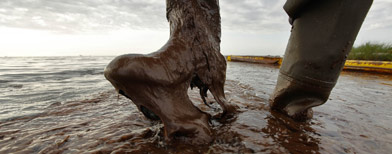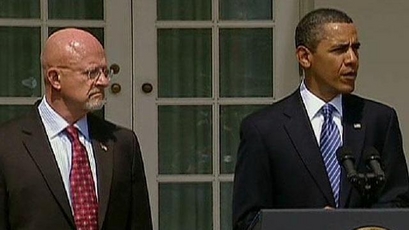VENICE, La/PENSACOLA BEACH, Fla (Reuters) – The latest effort to siphon oil and gas gushing from a ruptured deep-sea wellhead in the Gulf of Mexico is working well so far, U.S. officials said on Saturday, as President Barack Obama defended his handling of the environmental crisis.
British energy giant BP Plc said it collected 6,077 barrels (255,000 gallons/966,000 liters) of oil per day from the well on Friday, and that "improvement in oil collection is expected over the next several days."
After soiling wetland wildlife refuges in Louisiana and barrier islands in Mississippi and Alabama, the black tide of pollution has reached some of the famous white beaches of Florida.
The toll of dead and injured birds and marine animals, including seaturtles and dolphins, is also climbing.
But 47 days into the crisis and after several unsuccessful attempts at containment by BP, a partial solution finally appears at hand.
The containment cap that BP clamped over the leak earlier this week was siphoning oil to a waiting drill-ship at a faster rate than initially estimated, U.S. Coast Guard Admiral Thad Allen said at a briefing in Theodore, Alabama.
Bob Fryar, senior vice president with BP, later told a meeting of local mayors in Alabama that the latest undersea containment effort had gone "extremely well" so far.
The collection rate is still only about one-third of one day's flow from the oil geyser, which has been estimated by the government at about 19,000 barrels (800,000 gallons/3 million liters) per day.
But it could mark a turning point in the drama that has riveted the world and forced the Obama administration to reconsider plans to expand offshore oil drilling, which was seen as way to reduce U.S. dependence on foreign oil.
Allen said the full capacity of BP's containment device was about 15,000 bpd, the "upper limit" of the current leak control effort. BP does not expect to fully halt the oil flow until August, when two relief wells are due to be completed.
He said that winds continue to push parts of the vast oil slick closer to the coastline across a wide area -- roughly from the Mississippi-Alabama border to Port St. Joe in the Florida Panhandle, or more than 200 miles.
Florida's fishermen got a glimmer of good news late on Friday when the National Oceanic and AtmosphericAdministration reopened about 16,000 square miles (41,400 sq km) that had been closed to fishing on June 2 as a precaution.
Still, fully one-third of Gulf federal waters, or 78,603 square miles (203,582 sq km), remains closed to fishing in waters off four states. The U.S. shrimp and oyster supply, in particular, is heavily concentrated in the Gulf.
OBAMA'S TEST
In his weekly radio address on Saturday, Obama defended his administration against charges it had not moved aggressively enough in its response to the worst oil spill in U.S. history, which followed an April 20 rig blast that killed 11 workers.
Obama, who made a third trip to the Gulf coast on Friday, said he has put in place the largest response to an environmental disaster in U.S. history. The government had been "mobilized on every front," he said.
Meanwhile, BP said it had no specific pre-allocated budget to pay damages claims resulting from the spill, but will pay all those "hurt, harmed or damaged" until all legitimate claims are satisfied,
"We will make these payments for as long as it takes ...There is no budget, we'll do this until it's finished," BP America Vice President of Resources Darryl Willis said in a conference call from Orange Beach, Alabama.
The company faces a U.S. criminal probe, several lawsuits, dwindling investor confidence and growing questions about its credit-worthiness. Its share price has been stripped of about one-third of its value since the crisis began.
BP Chief Executive Tony Hayward has insisted the company had plenty of money to meet its obligations, including $5 billion in cash and additional credit lines it could tap.
The company has said it had already spent $1 billion on the disaster.
It is preparing to send a second advance payment to individuals and businesses along the Gulf Coast to compensate for the loss of income as a result of the spill. About 14,000 individuals and businesses will have received about $84 million once the second payment is processed.
The company delayed a decision on Friday to suspend its quarterly dividend payments, as some U.S. politicians have demanded.
SUNSHINE STATE TARRED
The far-flung but fragmented oil slick appeared to make its first landfall in Florida on Friday as tar balls and an oily sheen washed up on Pensacola Beach on the Panhandle.
Tar ball sightings were fewer on Saturday, but residents and environmental officials were still uneasy.
"BP can't stop it, I don't think the Navy or the military can stop it," said local businessman Michael Penzone. "If we can get people to come out and start praying, maybe something good can come out of this."
Local officials are bracing for more impact from the spill on Florida's $60 billion-a-year tourism industry.
Protesters planned an anti-BP rally for Sunday at a BP gas station in downtown Pensacola -- although such grass-roots actions are mostly seen as damaging to small business owners who run the stations.
In Orange Beach on Alabama's Gulf shore, BP's Fryar faced anger from local mayors about what was termed the company's sluggish response to oil clean-up on local beaches.
"We just climbed out of a hole, from two hurricanes and two years of recession. This was going to be a banner year, and BP killed it," said Tony Kennon, mayor of Orange Beach, just west of the Florida border.
WILDLIFE IMPACT GROWS
Latest figures from the U.S. government on Friday showed 527 birds across the Gulf Coast have been collected dead over a 45-day period, although not all showed signs of oil.
Tom Bancroft, chief scientist for the National Audubon Society, said the government's numbers tell only part of the story. "Some (birds) just sink under the water and will never be counted," he said.
Of particular concern, Bancroft said, are threatened shore birds that breed on Gulf Coast beaches. The spill could also be "a really bad setback" for the brown pelican, Louisiana's state bird, which was only removed from the endangered species list in 2009.
NOAA also reported many heavily oiled sea turtles in the spill zone. The turtles are being caught, cleaned and transported to an Audubon Aquarium outside New Orleans for further care. Dozens of dead dolphins have also been stranded within the spill area since late April.
(Additional reporting by Chris Baltimore in Houston, Pascal Fletcher in Miami, Jeff Mason in Kenner, La., Kelli Dugan in
Orange Beach, Alabama, Sarah Irwin in Buras, Louisiana, and Jane Ross in Pensacola; Writing by Ros Krasny; Editing by Philip Barbara and Paul Simao)





Tidak ada komentar:
Posting Komentar